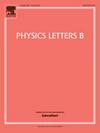Interpretable machine learning approach for electron antineutrino selection in a large liquid scintillator detector
IF 4.3
2区 物理与天体物理
Q1 ASTRONOMY & ASTROPHYSICS
引用次数: 0
Abstract
Several neutrino detectors, KamLAND, Daya Bay, Double Chooz, RENO, and the forthcoming large-scale JUNO, rely on liquid scintillator to detect reactor antineutrino interactions. In this context, inverse beta decay represents the golden channel for antineutrino detection, providing a pair of correlated events, thus a strong experimental signature to distinguish the signal from a variety of backgrounds. However, given the low cross-section of antineutrino interactions, the development of a powerful event selection algorithm becomes imperative to achieve effective discrimination between signal and backgrounds. In this study, we introduce a machine learning (ML) model to achieve this goal: a fully connected neural network as a powerful signal-background discriminator for a large liquid scintillator detector. We demonstrate, using the JUNO detector as an example, that, despite the already high efficiency of a cut-based approach, the presented ML model can further improve the overall event selection efficiency. Moreover, it allows for the retention of signal events at the detector edges that would otherwise be rejected because of the overwhelming amount of background events in that region. We also present the first interpretable analysis of the ML approach for event selection in reactor neutrino experiments. This method provides insights into the decision-making process of the model and offers valuable information for improving and updating traditional event selection approaches.大型液体闪烁探测器中电子反中微子选择的可解释机器学习方法
一些中微子探测器,如 KamLAND、Daya Bay、Double Chooz、RENO 和即将推出的大型 JUNO,都依靠液体闪烁体来探测反应堆的反中微子相互作用。在这种情况下,反贝塔衰变是反中微子探测的黄金通道,它提供了一对相关事件,因此具有很强的实验特征,可以将信号从各种背景中区分出来。然而,由于反中微子相互作用的截面较低,要有效区分信号和背景,就必须开发一种强大的事件选择算法。在本研究中,我们引入了一种机器学习(ML)模型来实现这一目标:将全连接神经网络作为大型液体闪烁体探测器的强大信号-背景判别器。我们以 JUNO 探测器为例证明,尽管基于切割的方法已经具有很高的效率,但所介绍的 ML 模型还能进一步提高整体事件选择效率。此外,它还允许在探测器边缘保留信号事件,否则这些事件会因为该区域的背景事件数量过多而被剔除。我们还首次提出了反应堆中微子实验中事件选择 ML 方法的可解释性分析。这种方法深入揭示了模型的决策过程,为改进和更新传统的事件选择方法提供了有价值的信息。
本文章由计算机程序翻译,如有差异,请以英文原文为准。
求助全文
约1分钟内获得全文
求助全文
来源期刊

Physics Letters B
物理-物理:综合
CiteScore
9.10
自引率
6.80%
发文量
647
审稿时长
3 months
期刊介绍:
Physics Letters B ensures the rapid publication of important new results in particle physics, nuclear physics and cosmology. Specialized editors are responsible for contributions in experimental nuclear physics, theoretical nuclear physics, experimental high-energy physics, theoretical high-energy physics, and astrophysics.
 求助内容:
求助内容: 应助结果提醒方式:
应助结果提醒方式:


